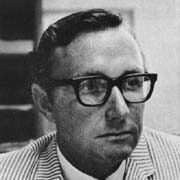John Griffin
- 1968

Fellowship Title:
- Pacific Islands
Fellowship Year:
- 1968
A Pacific Summing-Up
Honolulu December 7, 1970 Part I Ten thousand islands lie south and west of Hawaii in the world’s largest ocean. Pacific waters wash across a third of the globe, an area more than 20 times the size of the U.S. Mainland. The island area in the Pacific tropics is called Oceania, It sprawls some 5,000 miles between the west coast of the Americas and the edge of those other bigger islands that are part of Asia — Japan, the Philippines, and Indonesia. Oceania’s islands feel the influence of fringing nations in varying degrees. Above the equator, U.S. strategic interests are strong and controversial. Below it, Australia and New Zealand are economically active. Japan is making a commercial comeback. Indonesia uncomfortably holds half of New Guinea. Yet the tropical Pacific Islands themselves remain an entity worth noting, if only because they are largely dependent and underdeveloped — the world’s last emerging colonial area now coming of age. By the usual measures, the area is not large. There are only some 4 million people, about the number
Pacific Unity and Division
Honolulu December 4, 1970 It may well be that the Pacific Islands will be mostly preoccupied with their own emergence and development in the early years of the 1970s. Regionalism has special problems in an ocean so vast. Still, there has been both past experience and growing feeling on the question. Much of it centers on the area’s major ongoing organization, The South Pacific Commission, the closest thing to a Pan-Pacific Islands parliament. SPC Meeting in Suva The Commission was formed in 1947 by the so-called “metropolitan” or colonial powers — Australia, France, New Zealand, Britain, the U.S., and the Netherlands (which quit in 1962 when its West New Guinea colony went to Indonesia). Western Samoa was admitted to the metropolitan group when it became independent in 1962. The tiny but rich republic of Nauru joined in 1969. Independent Fiji is now eligible. So is the kingdom of Tonga, but its leaders have decided to hold back in a bid for more islander power. The Commission was set up with headquarters in Noumea,
Independent Fiji
Honolulu December 1, 1970 Fiji has become the Pacific’s newest nation in a manner so smooth that it mutes, and even hopefully has a positive effect upon, the deeper political, racial, and economic questions about its future. It was done in fine British style and subdued Fijian celebration with the Queen represented by her son, the young Prince of Wales. Instead of the dramatic midnight break, Fiji’s ceremonies were spread over two days. At sunset, October 9, the British flag was lowered for the last time as Fiji’s military band played the hymn, “The Day Thou Gavest, Lord, Is Ended.” Next morning in brilliant sunshine, Fiji’s sky blue flag was raised, and the Queen’s message welcomed a new Dominion to the Commonwealth. The new flag It was moving but simple. The mood was not wild celebration, and there were no demonstrations. Rather it was happiness shadowed by many mixed emotions by many people. For the British, Fiji independence means another step back from an empire that long ago proved economically and politically unprofitable;
New Hebrides: The Off-Beat Isles
Honolulu September 18, 1970 People often ask what is my favorite place after so much travel in the Pacific Islands, It is almost impossible to answer; there are too many different kinds of natural beauty, politics, problems, and interesting people. But no islands in this largest of oceans have more off-beat intrigue than the New Hebrides at the heart of oceanic Melanesia, west of Fiji, north of New Caledonia, south of the Solomons, and very much East of Eden. You are there only one day before you think, “Somebody should write a musical about this place.” Then you remember somebody has. It was called South Pacific, and some scenes from the Broadway hit and James Michener’s novel linger — the rusting remains of great military bases fringed by jungle; French planters, some greying and handsome; a few Tonkinese, as shrewd but more sophisticated than Bloody Mary; colonial Englishmen who could have been coast watchers; even a distant island that stands high and beautiful then fades in cloud and shadow so that some say
New Caledonia: French Forever?
Honolulu March 25, 1970 It is Noumea, the capital of French New Caledonia. A small, bright, and very black Solomon Islander, in town for the South Pacific Commission meeting, shivers in the chill night air despite his unaccustomed suit. “You know what I wonder about this place? “ he says looking at his glass of dark red wine. “Where are the natives? They must have pushed them back into the bush.“ He has a point. There are many Melanesians about this big, cigar-shaped island halfway between Fiji and Australia, as well as several other Pacific peoples. But in contrast to Tahiti, the overwhelming impact on arrival in Noumea is French: The cab driver coming in from the airport is a young Frenchman. The waiter at your hotel is French. So are some of the street cleaners. And the weather, the California-ish landscape, much of the architecture, the mixture of sun, sea, bikinis, even the cars and the desperate driving style — all often hint as much or more of Southern France as South
